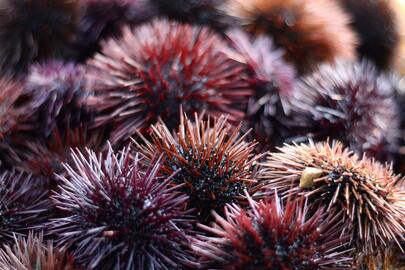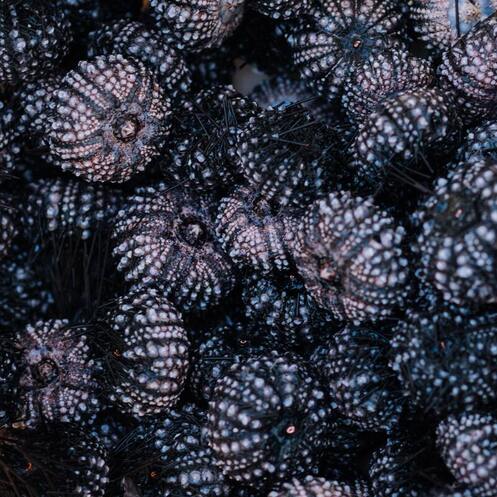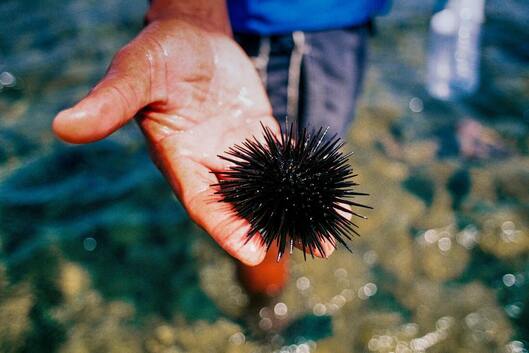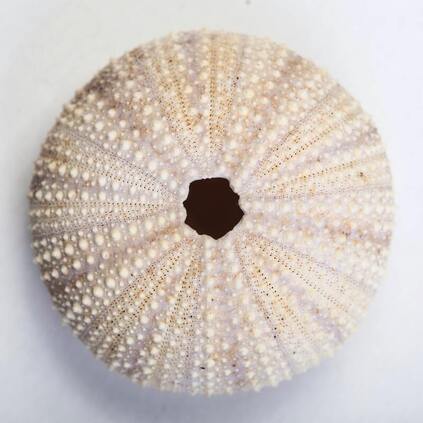 Sonia Kowsar via Unsplash Sonia Kowsar via Unsplash Sea urchins are an animal called Echinoidea that call the ocean bottoms home. They are globular creatures with shells that are covered in spikes. They are sessile and are slow-moving; they move using the tube feet. They usually thrive on algae but can also prey on small sessile beings. They are used by humans in aquariums to control algae. They are also a very popular delicacy around the world. The gonads of the creature are very popular as food. Sea urchins are a novel model for genome study, and their eggs have been used for experimentation as well. They are also studied for their certain characteristics. For example, they do not necessarily fit in the classic definition of aging; they age phenomenally well. These creatures can heal injuries of the spine and regrow their lost appendages. They even retain their healing characteristics throughout their lives. They can even reproduce in their late ages as if they’re still young. At even the micro-level, it has been observed that they do not undergo the age-related telomerase shortening. This study is a new field of research and shows a lot of promise. And above all, the sea urchins have a genome that overlaps with many genes in the human. For example, the gene of a purple sea urchin (Strongylocentrotus purpuratus) was sequenced, and about 23000 genes were found to be common between the sea urchin and humans. These genes are related to ageing disease and chemoreception vision and balance. This research might lead to a greater understanding of vertebrates and might even help us understand the roles of different genes and mechanisms in aging and longevity in humans. Do sea urchins age? Aging varies from species to species and is accompanied by a very complex mechanism of senescence. In humans, a shortening of telomeres, mitochondrial loss of function, decreased intracellular communication and decreased stem cell activity have been seen. And there are evident changes in the physical form as well in humans apart from micro-level changes. But the spikey ocean floor dwellers are different in this respect. There are both long and short-living species of sea urchins. Both have the regenerative ability, disease resistance, and show the least bit of senility. They grow indeterminately and reproduce throughout their life. Some species are short-lived, while other long-lived species can live for over 200 years. And when they die, that’s not because of old age or cell degradation, like humans. This lifespan diversity among sea urchin species and extreme longevity has intrigued many scientists to question their ageing process. James A. Coffman, a scientist from the Mount Desert Island (MDI) Biological Laboratory and Andrea Bodnar, a scientist at the Bermuda Institute of Ocean Studies, looked for the key that might help unlock the secrets of how to slow down the ageing in humans. They studied three species of sea urchins with short, intermediate, and long life expectancies and grouped them as young and old sea urchins. These include green sea urchin (Lytechinus variegatus); a short-lived sea urchin which dies after 4 or 5 years of life, purple sea urchin (Strongylocentrotus purpuratus), which lives up to 50 years; and red sea urchins (Mesocentrotus franciscanus), which has lived the earth for over 200 years. These were collected around Bermuda, San Diego, and British Columbia. This NIH (National Institute of Health) funded research on “Maintenance of Somatic Tissue Regeneration with Age in Short- and Long-lived Species of Sea Urchins'' was published in a leading journal, Aging Cell. Researchers that the short-lived sea urchin would exhibit a decline in regenerative capacity with age. That it would invest less energy into maintaining, repairing, and defending its body. What they discovered left them in awe. Much to their surprise, however, they found that even a short-lived green sea urchin doesn’t die of old age, regardless of how quickly it aged! Neither its cells degrade, nor it loses its regenerative ability. It maintained youthful functions to the end of their life. “There’s no difference in the regenerative ability of young and old sea urchins,” remarked Coffman. Coffman & Bodnar concluded that a physical decline and loss of regenerative ability is not necessarily inevitable for aging. So, what makes them exhibit such bizarre anomalous behaviour? To Bodnar and Coffman, it is a mystery. They suggested extensive research of the regenerative process in sea urchins will shed light on aging in humans. A team of researchers from the Department of Human Biology, Faculty of Natural Sciences, University of Haifa have studied and listed the following as possible reasons for how sea urchins successfully defy aging throughout their lives. 1- Notch signalling One thing that enables sea urchins to live for exceptionally long life spans is increased notch signalling. But what is notch signalling? Notch signalling is a process that is used by the multi-cellular organisms with which they control the fate of the cells. That is, differentiation, proliferation, and apoptosis. In humans, as age increases, this notch signalling decreases in the muscles tissues, and this shows a loss of muscle mass with the progression of age. But in sea urchins, the increased notch signalling helps them evade ageing and also provides them with regenerative abilities. Absence of the telomerase shortening Another part of this puzzle is the absence of the telomerase shortening in both short and long-lived sea urchins. Telomeres are the repeated sequence at the end of a linear chromosome. These telomeres are at the end of the chromosome and play an important role in cell divisions. But as age progresses, these telomeres shorten with each cell division and cause cell death. Telomeres can be maintained and protected by the presence of telomerase. Humans in their early life have this telomerase but are shut down as life progresses. They are only present in the stem cells as they are required for repair in case of injuries and have high proliferative strength. They are also present in the cancer cells; almost all cancer cells are telomerase positive. Sea urchins show a lifelong activity of telomerase in all the cells, and there is no shortening of telomeres as well. Hence, the longevity of the life span and rarely any neoplasm has been seen in them. However, unlike their centenarian cousins, some species of sea urchins, like green sea urchins, live comparatively short lives (4-5 years) despite the telomerase activity. So, this leaves us with an interesting question; why or how do they die? Loss in the activity of stem cells Another change with ageing is the loss in the activity of stem cells. Maintenance of the tissue homeostasis is essential, and the cells that are normally or during an injury turned over are replaced by the stem cells, which then differentiate and replace the cells. But as age progresses, the decrease in the stem cell activity and different intracellular processes occur that help in the deterioration of these cells. But the analysis of different genes like PCNA, TERT, SEAWI, and VASA protein reveals that age has no effects on them. PCNA is proliferating cell nuclear antigen. It is a part of polymerase and is an essential part of eukaryotic DNA. TERT is a part of the telomerase, and the PIWIn is a sea urchin version of the protein that is a part of the PIWI argunate protein family. And VASA protein is a part of the dead box protein family. The analysis of the amputated limbs was tested for these genes, and a reverse transcriptase PCR was used to test these genes. The Bottom line Previously, it was believed that aging is a side-effect of genes promoting growth, development, and reproduction, leading to a decline in regenerative capacity after reaching a certain age of reproductive maturity. It is time we rewrite our evolutionary theories about ageing and senescence. We may have to rethink theories on why aging occurs, says Coffman. Sea urchins show a fascinating escape from the biological aging process. And the fact that they have genes in common with humans shows a promise that they might be the step ladder that may lead us to superhuman longevity with reduced side effects of ageing. But the research is very new. The work of the scientists in the last two decades is what has pushed this into the light. Their aging mechanisms and their human implications are poorly understood. Therefore, further research is required on species like sea urchins, Galapagos turtles, sponges, clams, rockfish, and whales to learn about how they defy ageing and how it could be applied to humans to maintain a functional youthful age! Epigenetic profiling may help unravel the mysteries of these extraordinary animals as it is known that pathways involved in regulating senescence can be epigenetically modified. AuthorNida Riaz is a freelance blogger based in Pakistan. She started writing about her passion for the environment when the world came to a stop in early 2020.
0 Comments
Leave a Reply. |
|
|
(833) CMS-LINE
(833) 267-5463 PO Box 13477 Mill Creek, Wa, 98082 © Conservation Made Simple. All rights reserved.
501(c)(3) Non-Profit, Tax ID#: 82-1646340 Copyright © 2021 Conservation Made Simple |



